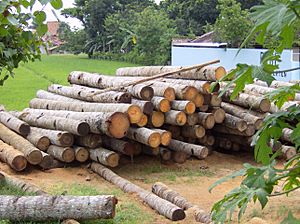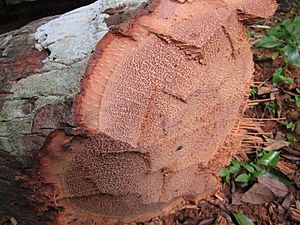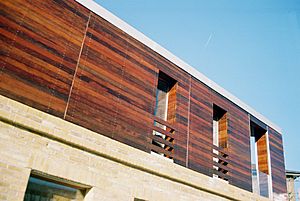Coconut timber facts for kids
Coconut timber is a special type of wood that comes from old coconut trees. It's also called coconut lumber or coco lumber in the Philippines, and sometimes cocowood or red palm. This wood is a new and exciting resource because it comes from farmed trees, offering a great alternative to cutting down trees in rainforests.
Contents
Where Does Coconut Timber Come From?
Coconut timber comes from large farms where coconut palms are grown. For many years, these trees were planted all over warm, tropical places to harvest their delicious coconuts.
A coconut tree usually produces fruit for about 70 years. After that, it doesn't make as many coconuts, so farmers cut it down to plant new, younger trees. Every year, millions of old coconut palms are cut down in tropical regions. For a long time, the trunks of these old trees were just thrown away.
But recently, people realized that these trunks could be used as a valuable source of wood! This led to the creation of coconut timber products, like flooring, furniture, and building materials. These products are often as good as, or even better than, wood from traditional hardwood trees. Using coconut timber helps protect our forests and gives us a strong, eco-friendly wood.
What Does Coconut Timber Look Like?
Coconut timber can look a bit like mahogany wood, but it has a more fibrous, stringy pattern. It doesn't have the shiny, shimmery look that mahogany sometimes has. The colors of coconut timber can range from a bright golden yellow to a very dark, almost black, brown. You'll often see dark brown speckles or flecks in the wood.
The color of the wood can tell you how strong it is:
- Dark brown wood is usually very strong and dense.
- Medium brown wood is moderately strong.
- Light golden wood is softer and less dense.
Unlike many other trees, coconut trees don't have yearly growth rings (like the rings you see in a tree stump). They also don't have knots or branches in their trunks. This means coconut timber is often very smooth and free of imperfections.
How Strong is Coconut Timber?
The coconut palm has a tall, thin trunk that can grow up to about 25 meters (about 82 feet) high. The trunk is usually around 300 millimeters (about 12 inches) wide.
The strongest and hardest part of the wood is found on the outer edge of the trunk. This outer part gives the tree its great strength. The wood also has a lot of silica, which is a natural mineral that helps make the tree flexible. As you move towards the center of the trunk, the wood becomes softer.
Coconut timber is actually very strong! It's even stronger than common woods like oak and Douglas fir.
Experts classify coconut timber into three groups based on how dense (or packed together) its fibers are:
- High-density timber: This is the hardest part, found on the outside of the trunk. It's very strong and heavy.
- Medium-density timber: This part is a bit softer than the high-density wood.
- Low-density timber: This is the softest part, found in the very center of the trunk. It's lighter and not as strong.
What Can Coconut Timber Be Used For?
Coconut timber is very versatile and can be used for many different things, both for building structures and for interior design.
- High-density timber (the strong stuff) is perfect for building parts that need to hold a lot of weight. This includes things like:
- Pillars (support columns)
- Floorboards and decking
- Furniture
- Window and door frames
- Medium-density timber can be used for parts of a building that don't need to be quite as strong, such as:
- Walls
- Ceiling supports
- Low-density timber (the softer wood) is great for things that don't need to bear weight. It's often used for:
- Decorative wood panels
- Inside trim
- Ceilings
- Small home items
Coconut timber has even been used in big projects, like the Masdar City development in Abu Dhabi, for things like entrance gates and doors!
How Does Coconut Timber Help People?
Coconut timber has become an important way for communities in less developed South Pacific islands to earn money. Before, the old coconut trunks were just waste. Now, they can be turned into valuable wood products, like veneers (thin layers of wood) and other items. This helps these communities by giving them a new source of income and making good use of a natural resource.




